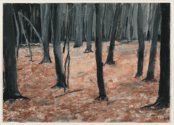[dropcap style=”font-size:100px; color:#992211;”]M[/dropcap]ore neatly than marmite, bagpipes or that EU referendum, the question of Morris dancing divides the nation.
For many it is, as folk musician Chris Wood puts it, the thing you cross the road to avoid.
I’ve always been rather fond of it.
I like the formal Cotswold style, with its bells and hankies, but I especially like Border Morris, originating in the Welsh-English borders, with its tattered clothes, be-feathered top hats, clacking sticks and general scary demeanour. I’ll stop and watch dancers of all kinds if I see them in the streets.
Much folklore has accrued around the subject of Morris dancing, especially to do with its supposed origins in an ancient pagan fertility cult. The fertility theory seems pretty implausible when you watch some of the, ahem, less virile sides splutter and wheeze their way through a dance, and in fact, Morris dancing began life in the Tudor Court, perhaps mimicking ‘Moorish spectacles’ in Spain.
From there it spread to the streets where it remains to this day. The top hats and the feathers are two-fingers raised to the aristocracy. We’ll wear your fine clothes and we’ll poach your pheasants while we’re about it.
For many now Morris dancing is a fun and social activity, one that gets you out and keeps you active. But the notion that Morris dancing has pagan origins has implicitly, and sometimes explicitly, inspired many of today’s sides. Meanings change. Who knows whether Morris dancers of yore danced the sun up on May 1st, but they do now, and that has a rightness to it.
These themes were touched on beautifully in the documentary, The Way of the Morris, and if you’re a waverer, I strongly recommend you watch it.
There is, of course, the vexed question of whether in a multi-cultural society it’s acceptable for Morris dancers to blacken their faces. I’ve hummed and hawed about this but am of the firm belief there’s no case to answer because it has absolutely nothing to do with ‘blacking up’.
Irrespective of the historical justifications that are offered for the practice, it’s all about intention.
Dressing up as a ‘Black and White Minstrel’ or to ape and lampoon an ethnic minority in any way is offensive and objectionable. If that’s what Morris dancers did, I would be their fiercest critic.
But spend five minutes watching them and you’ll see that the blackened faces have nothing to do with parody and everything to do with mask, with ritual, and with temporarily leaving the humdrum world behind.
Our local Dartmoor side, Beltane Morris, paint their faces because when they dance they embody the ravens who call the Moor home. Theirs is a bit of homegrown theriomorphism.
When the Seven Champions Molly dancers raise their hands to the sky, it is as if they are summoning up the spirit of the corn itself (Molly dancing is the East Anglian tradition). The effect is otherworldly and mesmerising.
And as if to hammer the point home, the Wild Hunt Border Morris actually wear masks.
If you watch one of the better sides dance until the spirit seems to grip hold of them, you realise that something odd and intangible is happening. Pagan or not, the Morris has become some kind of implicit folk ritual, a rite that allows something in and through, something that touches and transforms us, that connects our feet to the soil just as surely as it raises the hairs on the back of the neck.
You may feel that Morris dancing has nothing for you. I urge you to look again.
It’s what we have.
A writer and a folk musician, Andy is the author of ‘Shroom: A Cultural History of the Magic Mushroom’ and has published a range of articles and academic papers on subjects as diverse as psychedelics, paganism, bardism, environmental protest, fairies, shamanism and evolution. A modern day troubadour, he plays mandolin, writes songs, and fronts darkly crafted folk band, Telling the Bees. A leading exponent of the English Bagpipes, he plays for brythonic dancing in a trio called Wod.




















